Introduction to the Totem Heritage Center
Ketchikan, Alaska, is proudly known as the “Salmon Capital of the World,” but it is equally famous as the Totem Pole Capital of the World. Central to this identity is the Totem Heritage Center, a unique and vital cultural institution located just a short distance from the bustling downtown and cruise ship docks.
Brief History and Significance
The Totem Heritage Center was established in 1976 with a crucial mission: to save and preserve a significant collection of original, 19th-century totem poles. These poles were retrieved from abandoned Tlingit and Haida village sites—such as Village Island, Tongass Island, and Old Kasaan—after the residents moved to new settlements in the early 1900s.
- World’s Largest Collection of Unrestored Poles: The center houses the largest collection of unrestored 19th-century totem poles in the United States. These poles are preserved as they were found, displaying the natural effects of weathering and decay, which provides a fascinating look at their original lifecycle and the masterful craftsmanship that has endured for over a century.
- Cultural Preservation: More than just a museum, Totem Heritage Center is dedicated to perpetuating the living artistic traditions of the Tlingit, Haida, and Tsimshian peoples. It serves as a working cultural center, actively hosting classes and workshops in traditional Northwest Coast Native arts like carving, weaving, and regalia making.
Table of Contents
Why It’s a Must-Visit in Ketchikan
A visit to the Totem Heritage Center is an essential cultural experience for several reasons:
- Authenticity: Unlike the beautifully restored or replica poles you may see in other parks, the center displays the original, severely weathered poles, offering a humbling and authentic connection to the past.
- In-Depth Education: Totem Heritage Center provides the historical and cultural context needed to truly understand totem poles—they are not religious objects, but magnificent carved references to lineage, social standing, and the stories and legends of clans. Starting your totem exploration here will greatly enhance your appreciation for the poles you see elsewhere in Ketchikan.
- Easy Access: It is conveniently located and easily accessible from the cruise ship docks via a short, pleasant walk or a quick ride on the local bus/shuttle.
History of the Totem Heritage Center
The story of the Totem Heritage Center is one of rescue, cultural preservation, and a deep commitment to honoring the heritage of the Native Alaskan people of the Northwest Coast.
Origins and Establishment
The genesis of Totem Heritage Center lies in the early 20th century, when the inhabitants of remote Tlingit and Haida villages, such as Tongass Island and Old Kasaan, migrated to emerging towns like Ketchikan for proximity to schools, churches, and economic opportunities in the canneries and mines. They left behind their ceremonial houses and the magnificent totem poles, which were left exposed to the relentless elements of the temperate rainforest.
- Rescue Mission: Over the decades, the poles began to rot, decay, and were at risk of being lost forever. In the 1970s, a collaborative effort was initiated by the Alaska State Museum and the Alaska Native Brotherhood, with the permission and guidance of Native elders. Their goal was to retrieve the most endangered 19th-century poles.
- Founding: The Totem Heritage Center was officially established in 1976 to house this invaluable, rescued collection. It was designed to preserve the poles in a climate-controlled environment, safeguarding them from further deterioration while keeping them in Alaska, close to the communities they represent.
Preservation of Native Alaskan Culture
Totem Heritage Center is not simply a repository for old artifacts; it is a living cultural center dedicated to the perpetuation and teaching of Northwest Coast Native arts.
- Living Artistic Traditions: Totem Heritage Center preserves and promotes the traditional arts and crafts of the Tlingit, Haida, and Tsimshian peoples through nationally recognized programs. This includes workshops and classes in traditional skills like carving, basketry, weaving (such as Ravenstail weaving), and regalia making.
- Cultural Continuity: By displaying the original poles, the center offers a direct link between the carvers of the 19th century and the artists and students of today. This commitment ensures that the intricate art forms, techniques, and the cultural knowledge they embody are upheld and strengthened for future generations.
Importance of Totem Poles in Tlingit, Haida, and Tsimshian Traditions
To the cultures of the Northwest Coast, totem poles (or kootéeyaa in Tlingit) are profound, monumental works of art that serve as public affirmations of identity, history, and social structure.
- Commemorative Records: Totem poles are carved to honor important individuals, commemorate significant events (like a potlatch ceremony), and publicly proclaim the lineage and social standing of their owners. They are a tangible form of oral history.
- Clan Crests and Lineage: The figures carved on the poles are often crests—animals, mythological beings, or natural features—that symbolize a clan’s history and origins. These crests are considered the prized, intangible property of clans, passed down through generations to maintain a connection to their ancestors.
- Not Religious Objects: Contrary to popular Western misconception, the poles are not religious idols or objects of worship. They are historical and social documents that narrate stories known to the community and validate the privileges and rights of a family or clan.
Exhibits and Collections
The Totem Heritage Center is renowned worldwide for its unique collection, offering visitors an unparalleled look at the original, authentic carvings from the “golden age” of totem pole art.
The Totem Poles: Authentic 19th-Century Poles
The centerpiece of the Totem Heritage Center is its invaluable collection of 33 authentic 19th-century totem poles, making it the largest collection of unrestored poles in the United States.
- Unrestored and Weathered: Unlike many totem poles displayed in other parks and museums—which are often modern replicas or restored poles with fresh paint—the poles at the Heritage Center are displayed in their retrieved condition. These weathered, silvery-gray logs bear the visible scars of time, moss, and the decay they endured for decades in the rainforests of abandoned Native villages (Tongass Island, Village Island, and Old Kasaan). This unrestored state is crucial, as it preserves the original work and material in a climate-controlled environment, safeguarding them for future study and appreciation.
- Original Artifacts: The collection represents the peak of Northwest Coast carving, dating back 150 to 175 years. The poles are preserved as they were found, serving as direct, tangible evidence of the high level of skill and sophistication of the 19th-century Tlingit, Haida, and Tsimshian carvers.
- Other Artifacts: In addition to the poles, the center showcases a rotating collection of other priceless Tlingit, Haida, and Tsimshian artifacts, including:
- Woven baskets and textiles
- Ceremonial masks and regalia
- Traditional carving tools and implements
- Historical photographs that capture the poles as they stood in the original, abandoned village sites.
Stories and Meanings Behind the Carvings
Totem poles are essentially stories carved in wood, serving as visual archives of family, clan, and cultural history. The figures on the poles are not random decorations but are highly stylized symbols known as crests.
| Type of Pole | Purpose/Meaning | Key Figures and Symbols |
| Lineage/Heraldic Pole | Documents a clan’s ancestry, social standing, wealth, and the stories of how the clan acquired its crests. | Crests such as Raven, Eagle, Wolf, and Killer Whale, which represent a clan’s identity and ancestry. Tlingit society is divided into two moieties (halves): Raven and Eagle. |
| Memorial/Mortuary Pole | Honors the life of a deceased chief or important clan member. Some older mortuary poles contained the remains of the deceased in a box at the top. | Figures that recall the life, exploits, or clan affiliation of the person being honored. |
| Story Pole | Records significant historical events, legendary encounters with supernatural beings, or favorite myths that are central to the clan’s oral history. | Mythological beings like the Thunderbird or Kadjuk (a legendary bird), or figures depicting a moment from an important story, like the “Fog Woman.” |
| Ridicule (Shame) Pole | Erected to publicly shame a person or a group who failed to pay a debt or fulfill an obligation. | The carvings often symbolically depict the person or incident being ridiculed. (The Seward Pole in nearby Saxman Village is a famous example of a ridicule pole.) |
Understanding the Pole: The meaning of a pole is rarely obvious just by looking at the figures. The stories and their significance were traditionally explained and witnessed at the potlatch ceremony held when the pole was raised. These narratives were then passed down orally through the clan. Though the stories for some of the oldest poles in the Center have been lost, the poles remain vital links to the past, reminding visitors and carvers of the complexity and depth of the Northwest Coast cultures.
Native Artifacts and Cultural Items
Beyond the monumental totem poles, the Totem Heritage Center features significant collections of traditional arts and cultural objects from the Tlingit, Haida, and Tsimshian peoples, offering a richer context for the poles and a deeper understanding of Northwest Coast cultures.
Baskets, Regalia, and Ceremonial Pieces
The exhibits prominently showcase the incredible skill of Native artists in media other than wood carving:
- Woven Baskets and Mats: Totem Heritage Center displays intricately woven baskets and other woven items created from natural materials like cedar bark and spruce roots. These pieces highlight sophisticated techniques (such as Raven’s Tail Weaving) used to create both beautiful artistic pieces and essential utilitarian objects for cooking, storage, and gathering.
- Ceremonial Regalia: Visitors can view examples of rich ceremonial attire, including:
- Button Robes: Heavily decorated cloaks and vests adorned with intricate designs made of mother-of-pearl or abalone shell buttons, which display clan crests and are worn during important ceremonies like the Potlatch.
- Weavings and Textiles: Examples of elaborate woven garments and textiles used for ceremonial purposes.
- Masks and Carvings: The collection includes various masks (used in dances and ceremonies to represent spirit beings or ancestors), carved utensils, and other small, finely detailed objects that demonstrate the use of formline art in everyday and sacred life.
Exhibits Showcasing Traditional Lifestyles
The cultural exhibits at the Center are designed to illustrate the traditional worldview, social structure, and connection to the environment that gave rise to the art:
- The Traditional Setting: Exhibits use artifacts and, most notably, historical photographs to provide context. These photos, often taken before the poles were recovered, show the original 19th-century poles standing in front of traditional Native houses in the abandoned villages, allowing visitors to visualize the poles in their original environment.
- Traditional Tools and Techniques: Displays highlight the materials and processes used by the carvers and weavers, including examples of both ancient and early contact-era tools, which helped facilitate the flourishing of totem pole art.
- A Cultural Hub: Totem Heritage Center itself acts as a living cultural institution. It hosts the nationally recognized Native Arts Studies Program, where students learn and practice traditional arts like carving, weaving, and regalia-making from master Native artists. This commitment to education ensures the perpetuation of the “living artistic traditions” of the Tlingit, Haida, and Tsimshian peoples.
- Architecture: The building’s architecture is inspired by a traditional Northwest Coast clan house, immediately immersing visitors in the cultural setting where the art was originally created and displayed.
The Totem Heritage Center is not just a repository for 19th-century carvings; it is also a vital, active cultural center that utilizes rotating exhibits and events to perpetuate the living traditions of the Tlingit, Haida, and Tsimshian peoples.
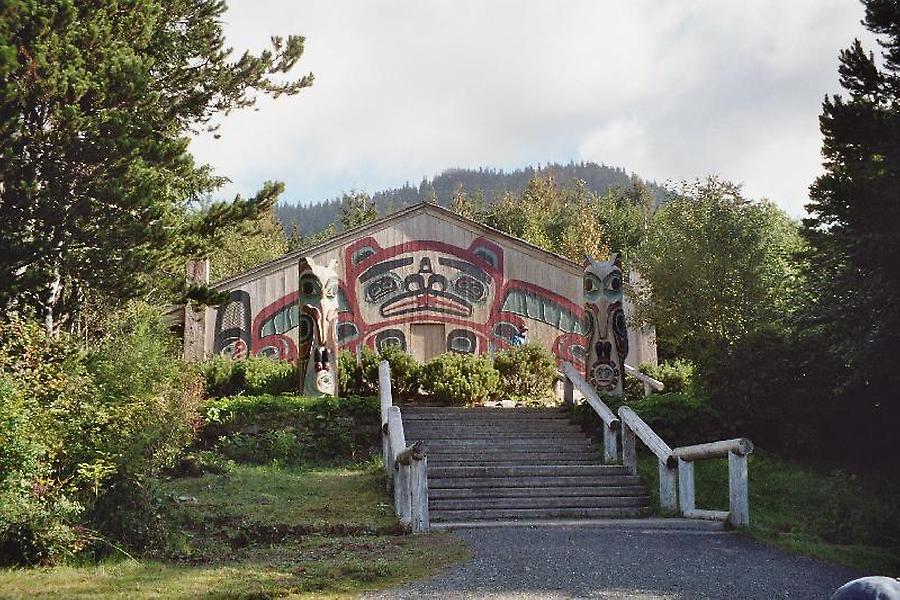
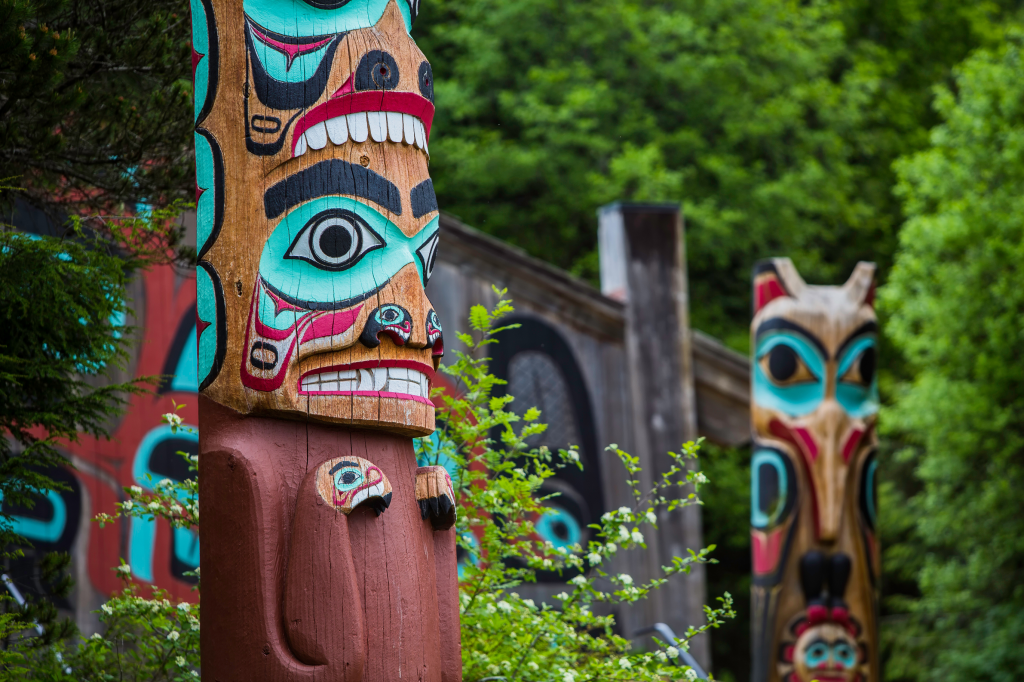
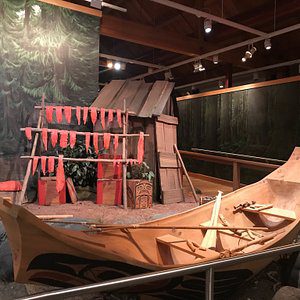
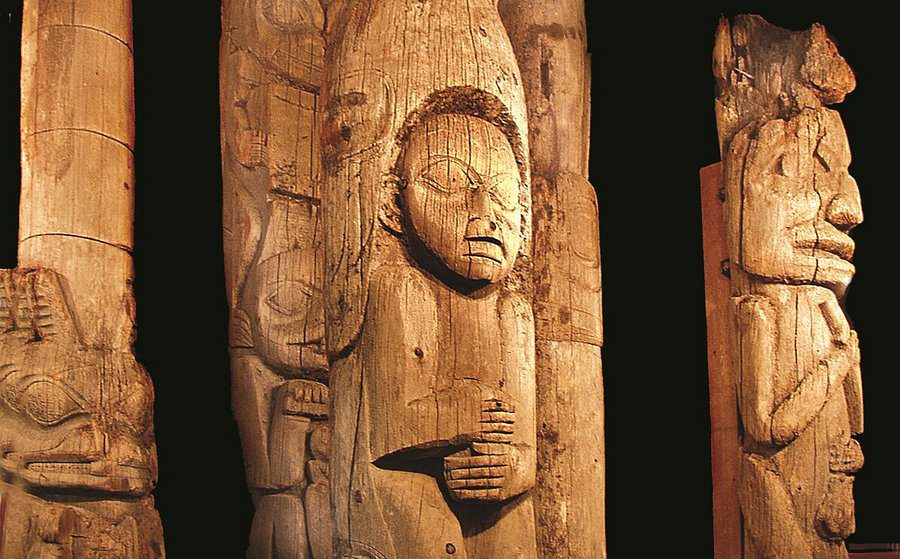
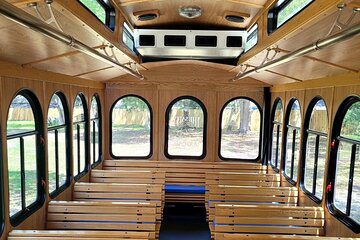
Local Artist Showcases
Totem Heritage Center features temporary exhibits that spotlight contemporary Northwest Coast Native artistry and the work of its students and instructors:
- Native Arts Studies Program (NASP) Showcases: A core function of the rotating displays is to exhibit the work produced through the Center’s formal Native Arts Studies Program. These showcases highlight the pieces completed by students and instructors in classes such as:
- Weaving and Basketry
- Carving and Engraving
- Regalia Making
- These exhibits serve to demonstrate the ongoing strength of the artistic traditions and the skill of local and regional artists who are keeping these ancient art forms alive.
- Contemporary Art: Totem Heritage Center frequently hosts temporary exhibitions dedicated to current Alaska Native artists, often featuring contemporary interpretations of traditional formline design in modern media, alongside the historical artifacts.
Cultural Events and Temporary Displays
The programming extends beyond the permanent collection to provide enriching, current cultural experiences:
- Rotating Theme Exhibits: One of the Center’s exhibit rooms is reserved for displays that change annually or seasonally. These temporary exhibits often delve into specific aspects of local Native and regional history, culture, or art that are not covered by the permanent collection.
- Featured Artworks: Individual pieces of contemporary or historical significance, such as a newly acquired Chilkat Robe, are sometimes featured as a temporary highlight to draw attention to exceptional craftsmanship and cultural narratives.
- Demonstrations and Workshops: As a center for learning and cultural preservation, the Totem Heritage Center periodically hosts live demonstrations by Native artists and master carvers. While these are not permanent displays, they are essential cultural events that allow visitors to see the creative process firsthand, thereby bridging the past and present.
The Totem Heritage Center is part of the Ketchikan Museums system, and its visitor information, including location and hours, are as follows:
Location and Hours
| Detail | Information |
| Address | 601 Deermount Street, Ketchikan, AK 99901 |
| Summer Hours (May – September) | Open Daily, 8:00 a.m. – 5:00 p.m. |
| Winter Hours (October – April) | Open Tuesday – Saturday, 1:00 p.m. – 5:00 p.m. |
| Admission | The pass includes admission to both the Totem Heritage Center and the Tongass Historical Museum. |
Totem Heritage Center is conveniently located a short distance from the downtown area and the cruise ship docks, about a 15-minute walk or a 5-minute drive.
The Totem Heritage Center, operated by Ketchikan Museums, offers clear admission prices and various options for guided tours.
Ticket Prices and Discounts
| Visitor Type | Single Museum Admission (Totem Heritage Center OR Tongass Historical Museum) | Museum Pass (Admission to BOTH Museums) |
| Adults | $6 | $9 |
| Elders (65 & older) | $5 | N/A |
| Children (17 & younger) | Free | Free |
| Active Military | Free | Free |
| Ketchikan Residents | Free | Free |
The Museum Pass provides the best value, granting access to both the Totem Heritage Center and the downtown Tongass Historical Museum.
Guided Tour Options
Totem Heritage Center offers both self-guided exploration and official structured tours:
- Self-Guided Tour: Visitors can explore the Center at their own pace. Informational plaques and display cases provide comprehensive details about the totem poles, artifacts, and cultural history. The average self-guided visit lasts 30 to 60 minutes.
- Official Guided Tours: The Ketchikan Museums staff offers enlightening tours for groups and classes.
- Public/Scheduled Tours: Totem Heritage Center often offers scheduled guided tours during the summer season, sometimes twice daily, led by knowledgeable guides who provide insightful narratives on the symbolism and stories behind the carvings. It is advisable to contact the Center directly to confirm the day’s tour schedule.
- Group Tours: Groups (such as school field trips or cultural interest groups) can arrange a specialized guided tour by contacting the Museums Program staff directly. These scheduled tours are generally 50 to 90 minutes long.
- External Tour Operators: Many commercial tour operators in Ketchikan include the Totem Heritage Center as a stop in their cultural and city highlights packages.
Accessibility and Facilities
The Totem Heritage Center, operated by the City of Ketchikan, is generally accessible to ensure a welcoming visit for all guests:
- Wheelchair Access: Totem Heritage Center is wheelchair-accessible, allowing visitors to comfortably navigate the interior exhibits and view the collection of historic totem poles.
- Parking and Transportation: Parking is available at the Center. For visitors arriving from downtown or the cruise ship docks, the free Salmon Run Bus shuttle stops nearby during the summer season (May to September).
- Amenities: The Center includes essential facilities for guests. As an official museum, it offers a wealth of information through plaques, exhibits, and staff. It does not have a cafeteria or gift shop, but it is located near City Park and is a short walk from downtown amenities.
Educational Programs
A key mission of the Totem Heritage Center is not just preservation, but perpetuation of the artistic traditions of the Tlingit, Haida, and Tsimshian peoples. This is achieved through its dedicated educational offerings:
Workshops and Classes (Native Arts Studies Program)
Totem Heritage Center runs the nationally recognized Native Arts Studies Program (NASP), which hosts classes, workshops, and courses throughout the year, especially during the off-peak season (October to April). These programs are taught by master Native artists and cultural experts.
- Focus Areas: Classes cover highly specialized, traditional Northwest Coast arts, including:
- Carving and Engraving
- Basketry and Weaving (including Raven’s Tail weaving)
- Regalia Making (such as Button Robes)
- Certification: Students can pursue a Certificate of Merit in Carving, Weaving, or Regalia, validating their proficiency in these traditional art forms.
Cultural Demonstrations
While not formally scheduled daily, Totem Heritage Center regularly integrates cultural and educational activities for visitors:
- Live Artist Demonstrations: Totem Heritage Center frequently hosts live carving demonstrations and weaving workshops that visitors can observe, offering a unique opportunity to see the creation process of these complex art forms firsthand.
- Guided Learning: Staff members and knowledgeable guides provide enlightening tours and are available to answer questions about the symbolism, clan histories, and techniques related to the exhibits.
- Film and Media: Totem Heritage Center utilizes film and other media to provide comprehensive context and oral histories about the practices of creating totem poles and the traditions of the Native villages from which the poles were recovered.
The Totem Heritage Center actively supports educational and group visits through the Ketchikan Museums program staff. They offer tailored arrangements to enhance the learning experience for students and large parties.
Educational Trips for Students (School Field Trips)
The Ketchikan Museums system highly encourages educational trips for students and offers dedicated programs to connect them with local Tlingit, Haida, and Tsimshian history and culture:
- Customized Programs: The Museums staff is prepared to create a program, tour, or activity specifically for a school class or youth group at both the Totem Heritage Center and the Tongass Historical Museum.
- Focus Areas: Programs often include:
- Guided tours detailing the symbolism and stories of the historic totem poles.
- Activities and crafts related to local Native culture.
- Local School Policy: School field trips and youth group tours are typically free for local residents when arranged with at least two weeks’ notice.
- Duration: Structured school field trips and scheduled tours generally last between 50 and 90 minutes.
Special Group Arrangements
For cruise ship passengers, non-local organizations, and general large groups, special arrangements can be made:
- Group Tours: Guided tours are available for cultural interest groups and pre-arranged large parties, offering an in-depth look at the collection of 19th-century totem poles.
- Tour Request Form: To schedule a specialized group tour, the Ketchikan Museums department recommends filling out their Tour Request Form or contacting the Programs staff directly.
- Contact Information: You can reach the Programs staff by phone at (907) 225-5900.
- Group Size: Visitors should discuss their group size and specific needs when arranging the tour to ensure adequate staffing and a quality experience.
Booking a special group tour in advance is strongly recommended, especially during the busy summer cruise season, to ensure staff availability.
The Totem Heritage Center is conveniently located near several of Ketchikan’s most popular cultural and natural attractions.
Here are details on nearby attractions:
Saxman Totem Park
The Saxman Totem Park is a separate, major collection of totem poles located just outside of downtown Ketchikan, offering a more extensive village setting.
- Distance from Totem Heritage Center: Approximately 2 to 3 miles south of the downtown corridor.
- Getting There:
- Driving: About a 5-10 minute drive south of the Totem Heritage Center.
- Bus: Accessible via the Borough Bus System (Silver Line South) or a short taxi ride.
- What to See: This park is an incorporated Tlingit village and features a large collection of restored and re-carved totem poles from abandoned villages, a traditional clan house, and often hosts Native cultural performances and carving demonstrations.
Creek Street
Creek Street is Ketchikan’s famous historic boardwalk and a must-see for visitors, known for its picturesque setting and colorful houses built on pilings over Ketchikan Creek.
- Distance from Totem Heritage Center: Very close, approximately a 15-minute walk (less than half a mile).
- Getting There: You can easily walk downhill from the Totem Heritage Center toward the creek. Many visitors follow the “Salmon Walk” path, which takes you right past the salmon ladder and into the Creek Street area.
- What to See: The area is now filled with art galleries, unique souvenir shops, and the historic Dolly’s House Museum. During the salmon run (typically July-September), you can often see salmon spawning in the creek right below the boardwalk.
Misty Fjords National Monument
The Misty Fjords National Monument is a vast, 2.3-million-acre wilderness area characterized by glacier-carved fjords, towering granite cliffs, and deep coastal rainforest. It is a premier natural attraction near Ketchikan.
- Distance from Ketchikan: The monument starts about 22 to 40 miles east of Ketchikan.
- Access: The Misty Fjords are a wilderness area with no road access. You can only visit by air or sea.
- Floatplane (Flightseeing): This is the most popular way to experience the fjords, offering a spectacular bird’s-eye view of the cliffs, waterfalls, and pristine lakes. Tours include a water landing in one of the fjords or lakes.
- Boat Tour (Day Cruise): High-speed catamaran tours depart from Ketchikan for a full-day excursion into the monument’s waterways, offering views from sea level and opportunities for wildlife viewing.
Tips for Visitors to the Totem Heritage Center
A visit to the Totem Heritage Center is a rich cultural experience. Planning your timing and approach can help maximize your enjoyment and ensure proper respect for the historic collection.
Best Time to Visit
The “best time” depends on your preference for crowds and operating hours:
- Peak Season (May through September):
- Pros: The Center is open daily from 8:00 a.m. to 5:00 p.m. This aligns with the cruise ship schedule, offering maximum flexibility. The free Salmon Run Bus shuttle runs to the area during these months.
- Cons: Expect higher crowds, particularly in the middle of the day when cruise ship traffic is heaviest.
- Off-Season (October through April):
- Pros: The atmosphere is much quieter and provides a more contemplative environment for viewing the poles. The Center’s Native Arts Studies Program is often in session, and you may be able to see local artists working (check the schedule for details).
- Cons: Limited hours (generally 1:00 p.m. to 5:00 p.m., days vary).
Pro-Tip: During the summer, visit early in the morning (8:00 a.m. to 10:00 a.m.) or late in the afternoon (3:00 p.m. to 5:00 p.m.) to avoid the mid-day rush.
Photography Guidelines
Photography is generally permitted inside the Center, but certain rules are in place to protect the historic poles and artifacts:
- No Flash Photography: Due to the fragility and age of the 19th-century totem poles, flash photography is strictly prohibited to prevent light damage. The lighting inside the Center is deliberately kept low for preservation.
- Use Handheld Devices Only: The Center is a relatively small space with low light. You should use a regular camera or camera phone for photography, as setting up tripods or large professional equipment is typically not permitted.
- Respect Restrictions: Always look for and obey any posted signs near specific exhibits or artifacts that might restrict photography. If you are unsure, politely ask a museum staff member.
Local Etiquette and Cultural Respect
The Totem Heritage Center preserves sacred cultural patrimony of the Tlingit, Haida, and Tsimshian people. Respectful behavior is paramount:
- Do Not Touch the Poles: The totem poles are irreplaceable cultural treasures, some over 150 years old. Do not touch, lean on, or climb on any of the poles, inside the Center or at the outdoor parks.
- Listen Attentively: If you are on a guided tour or listening to a cultural demonstration, listen respectfully to the Native guides and elders. They are sharing deep cultural knowledge.
- Use Correct Terminology: Ketchikan is home to the Tlingit, Haida, and Tsimshian people. Using their specific tribal names is a sign of respect and acknowledges their distinct cultural identities, rather than using broad, general terms like “Native American.”
- No Food or Drink: As with most museums, consuming food or beverages is not allowed inside the exhibit space to protect the artifacts from pests or spills.
- Ask Before Photographing People: If you wish to take a photograph of an Alaska Native person, especially a master artist who may be demonstrating carving or weaving, always ask for their permission first. This is a basic rule of courtesy and cultural sensitivity.
Conclusion: A Journey into Authentic Alaskan Heritage
The Totem Heritage Center is far more than just a museum; it is a vital sanctuary and a powerful cultural experience that makes it a must-see for any visitor to Ketchikan.
Why the Totem Heritage Center is a Must-See
The Center’s unique value lies in its irreplaceable collection and its crucial role in preservation:
- The World’s Oldest Collection of Totems: It houses one of the largest collections of original, unrestored 19th-century totem poles in the world. Unlike the brightly painted replicas you see in the totem parks, the poles here are displayed as they were recovered—weathered, silent witnesses to a lost era. They offer an almost spiritual connection to the past and the master carvers who created them.
- The Story of Preservation: The Center was founded with the blessing of Native Elders to save these magnificent poles from natural decay and theft, securing a crucial piece of cultural history for future generations. It is a living testament to the dedication of the Tlingit, Haida, and Tsimshian communities to keeping their heritage alive.
- A Deeper Cultural Understanding: The exhibits move beyond the carvings themselves, showcasing traditional artifacts, regalia, and photographs that immerse you in the lineage, beliefs, and stories associated with the poles. It provides the essential context needed to appreciate the broader Native Alaskan art and culture you see throughout Ketchikan.
Encouragement to Explore Native Alaskan Heritage
Your visit to the Totem Heritage Center is an opportunity to move beyond the typical tourist experience and engage with the enduring culture of Southeast Alaska’s First Peoples.
We strongly encourage you to embrace this journey:
Seek out the meaning, not just the image. The animals and figures on the poles are not random decorations; they are clan crests, family stories, and historical records. Take the time to read the accompanying information to understand the deep meaning etched into the cedar.
Support the living tradition. The Totem Heritage Center often hosts the Native Arts Studies Program, fostering the next generation of master carvers, weavers, and artists. Look for opportunities to see contemporary Native art or demonstrations to witness the unbroken lineage of these magnificent traditions.
By visiting with an open mind and respect, you become a partner in honoring the enduring legacy of the Tlingit, Haida, and Tsimshian people and ensuring their stories continue to be told.

